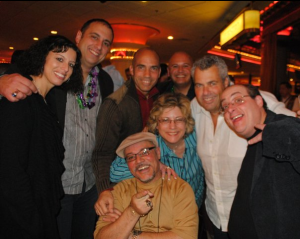

By Stu Chisholm, “The Complete Disc Jockey”
One of the many joys of being a DJ is that you never know what you’ll be doing next. While we might do an awful lot of weddings, we also find ourselves at the occasional Bar-Mitzvah, company picnic, car cruise or, in my case, doing the PA and acting as host for an expo. Trade shows and expos are a thriving business. Every industry has them, and there are sometimes various hobbies and interests that bring together various industries under one roof. For instance, I recently played host to the Great Lakes Emergency Preparedness Expo at Birch Run, Michigan. Commonly referred to as the “prepper expo,” as in “doomsday prepper” made popular by a show of the same name on the National Geographic Channel, this expo incorporated vendors usually not seen beyond gun shows, along with vendors from the camping, fishing and outdoor communities, solar and wind power companies, ham radio operators, food vendors (MREs and other food designed for long-term storage) and so on.
Such shows have many aspects in common, and if you’re tagged to provide PA, there are some things you should know.
THE BIG SHOW
Expo spaces tend to be vast, open areas where promoters can lay out booth spaces for vendors as they see fit. They tend to be either in rows in the middle of the space, lined-up along the walls or both. You can also expect a “main stage” to be set up either at the end, if the space is rectangular, or in the middle. In my case above, it was an “end cap” type of setting. This presents two problems; you must provide adequate sound for the seating area immediately in front of the stage, while at the same time getting sound out to the rest of the venue, but only loud enough to hear what’s going on. Too loud and the vendors cannot talk easily to the attendees, which takes precedence always.
For this reason, I saved my primary PA for the seating area, arranging my speakers to focus the sound at an imaginary point in the middle of the back row. This allows everyone to hear without too much sonic “slop” to the sides. I then ran another pair of speakers in mono, pointing down the main aisles of the expo area. Because the aisles are wide open, sound doesn’t fall off too quickly over straight line distance. This means that, while it will certainly be loudest to the vendors closest to them, you can adjust the levels to their liking and still have adequate sound some 60 to 80 feet down the aisle. It is important to place at least one speaker facing each aisle.
BETTER SOUND FOR LESS EFFORT
Another strategy that I’ve used to great effect is the wireless speaker transmitter, such as the Voco-Pro AirNet system. This way, speakers can be placed around the perimeter of the room running at low volume. Although they’re all running at low volume, the sound is spread out so that everyone can hear without there being a “hot spot” or blaring from any one direction; the same strategy employed by in-ceiling speaker systems in stores, restaurants, etc. (And yes, you can achieve the same results using a wired 70-volt speaker array, but why do that in this day and age?)
To feed the wireless transmitter/sound system, I opted to use a standard DJ-style mixing console rather than the band/PA-style board, just in case any presenter had a CD to play or a computer to plug in. (A projector and screen were set up for power point presentations.) My console also included a media player for anyone who had audio material on USB flash drives or SD cards. Lastly, I topped off the PA with a Voco-Pro 4-pack mic system usually used for Karaoke. These pack surprisingly good sound in a single, modestly priced package. I also brought along two headset mics with body packs that replace two of the channels in the system, just in case a presenter wanted to have his/her hands free.
THE FACE OF THE EXPO
Most promoters are quite relieved to have a real DJ agree to play host, or emcee the show for them. It is important, however, that the DJ brush up on the show’s details. You must know the schedule of events and even upcoming shows that the company wants promoted. It’s also helpful to have a list of the vendors, describing what it is that they do or sell. Learn the proper pronunciations of the special guest’s names, their groups or companies and what they’ll be speaking on.
Remember that you will be the “face of the show” to those in attendance! You will be representing the company producing the show. For these reasons it is important to not only look your best, but dress the part. For my “prepper” expo, I donned my 5.11 Tactical BDUs, boots and military-style cap. At another event with a Country theme, I recycled my cowboy look I tossed-together for a country themed wedding. While some expos may allow, or even demand, a tuxedo, it might be overdressed or even tacky at a good many events. A classic example during the spring months are the sci-fi and fandom expos/conventions. These are your chance to be creative and rise to the occasion. There’s more to dressing as the emcee than a power tie.
Lastly, expos often run for more than a single day. This maximizes your income and reduces your workload, since you only have to set up once. So until next time, safe spinnin’, and I’ll see you at the expo!
